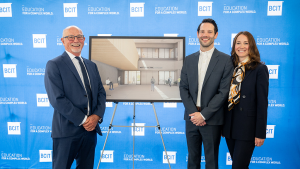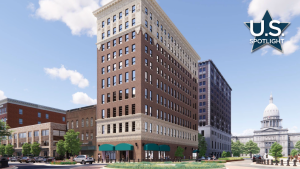Visitors to the Urban Ecology Centre at The Humber Arboretum in Etobicoke can expect to be treated to an education in green living.
Green Building
TORONTO
Visitors to the Urban Ecology Centre at The Humber Arboretum in Etobicoke can expect to be treated to an education in green living.
The $4 million facility, which opens in the fall, replaces the existing Nature Centre and will be used for research and education on urban ecology. It will feature a variety of ecologically sustainable techniques such as environmentally friendly building materials, solar power, wind power, on-site waste management and a living roof.
Carol Ray, Humber Arboretum’s special project coordinator, hopes the new centre will serve as a “green” example for the surrounding community and visitors.
“Our goal is to feature a facility, located within a premier urban ecosystem, with the lowest possible environmental impact, to provide an educational and research focus for the study of green technology and design,” she said. It will “provide a unique, tangible and enjoyable learning experience for both young people and adults.”
The new facility will be located at the Humber Arboretum, on the West Humber River adjacent to the north campus of Humber Institute of Technology and Advance Learning.
The City of Toronto, the Toronto and Region Conservation and Humber Institute of Technology and Advanced Learning manage the Arboretum in partnership.
During the planning stages, the architectural composition of the centre was heavily influenced by green principles, crucial to the building’s function as a teaching centre.
“The Centre will include an integrated monitoring and control system to allow for maximized energy efficiency and to provide data for researching the effectiveness of alternative, environmentally-friendly technologies in an urban public building,” she noted. “It will serve as an example through its unique design and use of new green technologies of how to construct in an ecologically positive way.”
In addition, it will also provide training and research opportunities for Humber students in programs including Environmental Technologies, Civil Engineering Technology, Architectural Technology, and Horticulture, to name a few.
Unlike starts to other building projects the original facility was not demolished and haphazardly carted away, instead it was “systematically” taken apart so most of the material could be reused and recycled.
Groundbreaking for the new centre took place in May, with an expected completion date set for November 2006.
To date $3.6 million of the estimated cost has been received through various fundraising campaigns, Ray said noting, there are still opportunities to support the project including naming opportunities.
Additional support came from Unilever Canada (for the green roof), Tridel/Hullmark, the Toronto Atmospheric Fund, TD Friends of the Environment Foundation, the Garfield Weston Foundation, TD Canada Trust, the Garden Club of Toronto, Suncor Energy Foundation, Mountain Equipment Coop, and individual donations.
The design of the centre is a joint venture between Taylor/Hazell Architects and architectsAlliance, Enermodal (mechanical/electrical), and Diana Gerrard (landscaping).
The centre will house a multipurpose sunroom and a nature activity centre on the lower level with access to the outdoors to allow for “learning adventures.”
“It has been designed to Gold LEED standards,” Ray said. “It will be an attractive two-level facility with expansive windows which present spectacular views of the adjacent gardens, woods and meadows.”
In addition, the “unique thermal shaft, a central focus, will provide natural cooling and ventilation and bring in natural light to the interior,” she added. “The Centre for Urban Ecology demonstrates an ecosystem approach to building with a positive impact on the natural and human community.”
Other sustainable features include passive solar heat sources, a vegetated green roof for storm water management and passive cooling, cistern for landscape irrigation, and plans include the phasing in of a wind turbine and photovoltaics.
The green technology features will collectively reduce the Centre’s impact on the urban environment and cut energy costs significantly Ray added. “[It] will serve as a model of sustainability for others to follow.”










Recent Comments
comments for this post are closed